To continue the Drop Everything and Read celebration, we have selected some books that are good read-aloud choices: picture books that children will enjoy listening to and novels that will have elementary-grade children begging to hear just one more chapter when they are read to them. The books we selected for older readers are good choices for independent reading. They are just the kind of books that teens can’t wait to talk about and pass on to friends once they have finished reading them.
Ages 4–8
Alan’s Big, Scary Teeth. Jarvis. 2016. Candlewick.
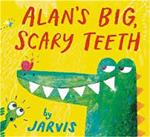 Alan, an alligator, is a bully. Every day he creeps through the jungle and snaps his razor-sharp teeth and grrrrrrowls! Frogs leap, monkeys tumble, and parrots screech. They are terrified, and Alan loves scaring them! But what happens when Barry the Beaver discovers that those teeth are false and tells the other animals? Jarvis’s playful, fun-to-read-out-loud language and bold, vibrantly colored illustrations make Alan’s Big, Scary Teeth a delightful and humorous picture book. Children will laugh when Alan says goodnight to his teeth after taking them out with a “Tweet dweams, my theary thnappers!” and later, when his teeth go missing and he exclaims, “MY TEETH! MY TEETH! WHEAH AH MY TEETH?” After having a good laugh at the toothless alligator, the jungle animals come up with solution for living together in harmony.
Alan, an alligator, is a bully. Every day he creeps through the jungle and snaps his razor-sharp teeth and grrrrrrowls! Frogs leap, monkeys tumble, and parrots screech. They are terrified, and Alan loves scaring them! But what happens when Barry the Beaver discovers that those teeth are false and tells the other animals? Jarvis’s playful, fun-to-read-out-loud language and bold, vibrantly colored illustrations make Alan’s Big, Scary Teeth a delightful and humorous picture book. Children will laugh when Alan says goodnight to his teeth after taking them out with a “Tweet dweams, my theary thnappers!” and later, when his teeth go missing and he exclaims, “MY TEETH! MY TEETH! WHEAH AH MY TEETH?” After having a good laugh at the toothless alligator, the jungle animals come up with solution for living together in harmony.
—NB
The Hole Story of the Doughnut. Pat Miller. Ill. Vincent X. Kirsch. 2016. Houghton Mifflin Harcourt.
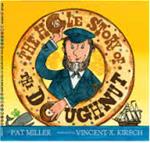 Hanson Crockett Gregory (1821–1921) had an adventurous life at sea, leaving his Maine home to become a cabin boy on the Isaac Achorn at the age of 13. He became a captain and was awarded a medal for heroism by Queen Isabella II for rescuing seven Spanish sailors after a disaster at sea. As a cook’s assistant on the Ivanhoe at the age of 16, Hanson invented the doughnut hole, which turned the balls of deep fat fried sweetened dough with heavy raw centers, which the sailors called “sinkers,” into fully cooked, tasty “holey cakes.” Miller includes colorful legends of the origin of the doughnut spun by sailors. The formatting of the text and the cartoon-like illustrations with a folk art flavor cleverly build on the doughnut’s shape and the nautical connection of its origin. (Don’t miss the octopus with a doughnut on each of its eight tentacles on the back cover.) Back matter includes an author’s note, timeline, and selected bibliography.
Hanson Crockett Gregory (1821–1921) had an adventurous life at sea, leaving his Maine home to become a cabin boy on the Isaac Achorn at the age of 13. He became a captain and was awarded a medal for heroism by Queen Isabella II for rescuing seven Spanish sailors after a disaster at sea. As a cook’s assistant on the Ivanhoe at the age of 16, Hanson invented the doughnut hole, which turned the balls of deep fat fried sweetened dough with heavy raw centers, which the sailors called “sinkers,” into fully cooked, tasty “holey cakes.” Miller includes colorful legends of the origin of the doughnut spun by sailors. The formatting of the text and the cartoon-like illustrations with a folk art flavor cleverly build on the doughnut’s shape and the nautical connection of its origin. (Don’t miss the octopus with a doughnut on each of its eight tentacles on the back cover.) Back matter includes an author’s note, timeline, and selected bibliography.
—CA
Hooray for Kids! Suzanne Lang. Ill. Max Lang. 2016. Random House.
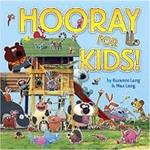 The exuberant title and cover art showing animals playing together on a playset will grab the attention of young children. The repetitive “whether you are” and trip-over-the-tongue descriptors such as “an always-asking-why kid,” “an upside-down-frown kid,” and “a wake-up-nice-and-early kid” of the text make this an ideal read-aloud. Collage art with colorful cartoon-like animal characters superimposed on photographed backgrounds contributes to the spirit of this picture book’s celebration of individuality. For example, the text “some kids do the crawl” is paired with an illustration of a crab on a beach and “some kids jump real high” with a bug leaping over a log. The book ends with the jubilant proclamation: “To all kids we say, each one of you is special. KID, KID, HOORAY!”
The exuberant title and cover art showing animals playing together on a playset will grab the attention of young children. The repetitive “whether you are” and trip-over-the-tongue descriptors such as “an always-asking-why kid,” “an upside-down-frown kid,” and “a wake-up-nice-and-early kid” of the text make this an ideal read-aloud. Collage art with colorful cartoon-like animal characters superimposed on photographed backgrounds contributes to the spirit of this picture book’s celebration of individuality. For example, the text “some kids do the crawl” is paired with an illustration of a crab on a beach and “some kids jump real high” with a bug leaping over a log. The book ends with the jubilant proclamation: “To all kids we say, each one of you is special. KID, KID, HOORAY!”
—NB
A Hungry Lion, or a Dwindling Assortment of Animals. Lucy Ruth Cummins. 2016. Atheneum/Simon & Schuster.
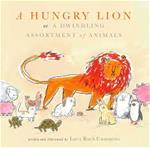 This picture book’s traditional “Once upon a time” beginning introduces a hungry lion and 13 cute small animals, including a penguin, a frog, a koala, and a hen. With each turn of the page, the hungry lion is still there, but the number of small animals dwindles until there is only a hungry lion and a turtle. Where did all the other animals go? What would you expect to happen when there is a hungry lion among an assortment of small animals? But reading on, there are some surprises, including a very big one that leads to an unexpected ending. The text and illustrations work together to create a playful and witty story with some dark overtones (including a totally black double-page spread) to read again and again.
This picture book’s traditional “Once upon a time” beginning introduces a hungry lion and 13 cute small animals, including a penguin, a frog, a koala, and a hen. With each turn of the page, the hungry lion is still there, but the number of small animals dwindles until there is only a hungry lion and a turtle. Where did all the other animals go? What would you expect to happen when there is a hungry lion among an assortment of small animals? But reading on, there are some surprises, including a very big one that leads to an unexpected ending. The text and illustrations work together to create a playful and witty story with some dark overtones (including a totally black double-page spread) to read again and again.
—CA
Ages 9–11
The Adventures of Lettie Peppercorn. Sam Gayton. Ill. Poly Bernatene. 2016. Margaret K. McElderry/Simon & Schuster.
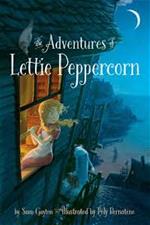 Lettie Peppercorn was only 2 years old when her mother mysteriously disappeared, leaving behind a warning for the toddler to never leave the house. Now, at age 12, lonely Lettie, who has followed her mother’s instructions to the letter, is landlady of the White Horse Inn, the family business, while her father spends his days at a local pub drinking and gambling. When an alchemist-turned-con man arrives at the Inn trying to sell Lettie his latest invention, snow-as-diamonds, she turns him down. However, two eccentric guests have plans to steal it. This sets off a twisted series of unlikely and supernatural events as Lettie courageously leaves the Inn to search of her mother. Will her newfound knowledge of alchemy be enough to bring her family together? Are family bonds stronger than magic? This fast-paced adventure takes readers on a fantasy trip they won’t forget.
Lettie Peppercorn was only 2 years old when her mother mysteriously disappeared, leaving behind a warning for the toddler to never leave the house. Now, at age 12, lonely Lettie, who has followed her mother’s instructions to the letter, is landlady of the White Horse Inn, the family business, while her father spends his days at a local pub drinking and gambling. When an alchemist-turned-con man arrives at the Inn trying to sell Lettie his latest invention, snow-as-diamonds, she turns him down. However, two eccentric guests have plans to steal it. This sets off a twisted series of unlikely and supernatural events as Lettie courageously leaves the Inn to search of her mother. Will her newfound knowledge of alchemy be enough to bring her family together? Are family bonds stronger than magic? This fast-paced adventure takes readers on a fantasy trip they won’t forget.
—NB
Some Kind of Courage. Dan Gemeinhart. 2016. Scholastic.
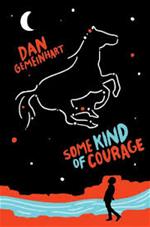 It’s 1890 in the newly formed state of Washington. Twelve-year-old Joseph Johnson, recently orphaned, is on a quest to find his beloved stolen horse, Sarah, his last tie to memories of his family. “Do the right thing” echoes in his heart as Joseph escapes with his father’s gun and the money that drunk, mean Mr. Grissom got for selling Sarah. He meets a young abandoned Chinese boy and, although they don’t speak the same language, Joseph and Ah-Kee develop a friendship. As they track Sarah through a string of horse owners, they share some chilling escapades, including a showdown with an angry bear, a near-death canoe ride down rapids, and the rescue of an injured Indian. After Ah-Kee is reunited with his family, Joseph continues his journey alone and confronts a bank robber and posse, leading to an unexpected catastrophe that changes his plans for the future. This historical novel works well as a read-aloud and will inspire discussions of courage, love, and acceptance of others.
It’s 1890 in the newly formed state of Washington. Twelve-year-old Joseph Johnson, recently orphaned, is on a quest to find his beloved stolen horse, Sarah, his last tie to memories of his family. “Do the right thing” echoes in his heart as Joseph escapes with his father’s gun and the money that drunk, mean Mr. Grissom got for selling Sarah. He meets a young abandoned Chinese boy and, although they don’t speak the same language, Joseph and Ah-Kee develop a friendship. As they track Sarah through a string of horse owners, they share some chilling escapades, including a showdown with an angry bear, a near-death canoe ride down rapids, and the rescue of an injured Indian. After Ah-Kee is reunited with his family, Joseph continues his journey alone and confronts a bank robber and posse, leading to an unexpected catastrophe that changes his plans for the future. This historical novel works well as a read-aloud and will inspire discussions of courage, love, and acceptance of others.
—NB
Ages 12–14
The Keeper of the Mist. Rachel Neumeier. 2016. Alfred A. Knopf/Random House.
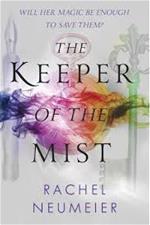 Lord Dorric Ailenn is dead, and young Keri, his illegitimate daughter, unexpectedly finds that the magic of Nimmira has chosen her to take his place as ruler of Nimmira rather than one of her three older half-brothers. As Lady Nimmira, Keri must immediately deal with the disappearance of the mist of concealment and misdirection that for centuries has kept Nimmira isolated and safe from ambitious sorcerers and warlike people of bordering countries Outside. The failure of the mist has allowed the entry of two envoys of the rulers of neighboring kingdoms intent on annexing Nimmeria. Keri must not only deal with these Outsiders but also decide whom she can trust within the House if she is to restore the mist and save Nimmira.
Lord Dorric Ailenn is dead, and young Keri, his illegitimate daughter, unexpectedly finds that the magic of Nimmira has chosen her to take his place as ruler of Nimmira rather than one of her three older half-brothers. As Lady Nimmira, Keri must immediately deal with the disappearance of the mist of concealment and misdirection that for centuries has kept Nimmira isolated and safe from ambitious sorcerers and warlike people of bordering countries Outside. The failure of the mist has allowed the entry of two envoys of the rulers of neighboring kingdoms intent on annexing Nimmeria. Keri must not only deal with these Outsiders but also decide whom she can trust within the House if she is to restore the mist and save Nimmira.
—CA
Will’s Words: How William Shakespeare Changed the Way You Talk. Jane Sutcliffe. Ill. John Shelley. 2016. Charlesbridge.
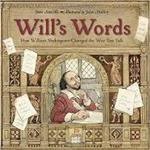 In an introductory letter to readers, Sutcliffe explains that she started to write about the history of the Globe Theatre and William Shakespeare but found it difficult to do so without Shakespeare’s words “popping up all over the place.” What follows serves as both an introduction to the history of London theater in the 1600s and Shakespeare’s contributions to the development of a colorful English language. On double-page spreads, a boxed paragraph of Sutcliffe’s text (with Shakespeare’s words in bold) is paired with a boxed item defining “Will’s Words” such as foul play and wild-goose chase and citing where the words or phrases appear in his plays. These are set against a background of Shelley’s intricately detailed pen-and-ink drawings colored in watercolor. Back matter includes a timeline and bibliography.
In an introductory letter to readers, Sutcliffe explains that she started to write about the history of the Globe Theatre and William Shakespeare but found it difficult to do so without Shakespeare’s words “popping up all over the place.” What follows serves as both an introduction to the history of London theater in the 1600s and Shakespeare’s contributions to the development of a colorful English language. On double-page spreads, a boxed paragraph of Sutcliffe’s text (with Shakespeare’s words in bold) is paired with a boxed item defining “Will’s Words” such as foul play and wild-goose chase and citing where the words or phrases appear in his plays. These are set against a background of Shelley’s intricately detailed pen-and-ink drawings colored in watercolor. Back matter includes a timeline and bibliography.
—CA
Ages 15+
I Woke Up Dead at the Mall. Judy Sheehan. 2016. Delacorte/Random House.
 Sixteen-year-old Sarah wakes up at the Mall of America in Minnesota dead and dressed in a hideous mango chiffon bridesmaid’s dress. Bertha, a death coach, is assigned to lead Sarah and a group of murdered teens through a letting-go process by having them share their death stories, revisiting one day from their lives, and attending their funerals. The alternative: Turning into Zombie-like “mall walkers,” stuck trudging hypnotically around the mall, day and night, repeating nonsensical phrases or, worse yet, having to relive their deaths over and over in a state of suspended consciousness. After Sarah accidentally discovers the identity of her killer and the killer’s next target, she puts her soul on the line to change the inevitable, but finds she can’t do it alone. With the support of her long-deceased mother and her new friends, Sarah sets out to stop a diabolical plot already in motion and make her death matter. This paranormal mystery is sure to entrance teen readers.
Sixteen-year-old Sarah wakes up at the Mall of America in Minnesota dead and dressed in a hideous mango chiffon bridesmaid’s dress. Bertha, a death coach, is assigned to lead Sarah and a group of murdered teens through a letting-go process by having them share their death stories, revisiting one day from their lives, and attending their funerals. The alternative: Turning into Zombie-like “mall walkers,” stuck trudging hypnotically around the mall, day and night, repeating nonsensical phrases or, worse yet, having to relive their deaths over and over in a state of suspended consciousness. After Sarah accidentally discovers the identity of her killer and the killer’s next target, she puts her soul on the line to change the inevitable, but finds she can’t do it alone. With the support of her long-deceased mother and her new friends, Sarah sets out to stop a diabolical plot already in motion and make her death matter. This paranormal mystery is sure to entrance teen readers.
—NB
The Leaving Season. Cat Jordan. 2016. HarperTeen/HarperCollins.
 It’s late August, what Middie Daniels calls the “leaving season,” during which high school graduates leave home for the first time. While Middie is just beginning her senior year, Nate, who has been her boyfriend since middle school, is leaving her. He is taking a gap year working with Global Outreach in Honduras. For Middie, it is going to be a year of her life on hold until Nate returns and she can join him on his path of college, medical school, marriage, and family. Then the unthinkable happens. News comes of the attack on the village where Nate is working: “Villagers and Medical Volunteers Killed While Fleeing.” In her grief, Middie is surprised to find she is drawn to Nate’s best friend, Lee, who is the complete opposite of predictable, purpose-driven Nate. As Middie and Lee become close, news comes that Nate has been found alive. Upon his return, Middie has some difficult decisions to make about the experiences and relationship she sees defining her now and in the future.
It’s late August, what Middie Daniels calls the “leaving season,” during which high school graduates leave home for the first time. While Middie is just beginning her senior year, Nate, who has been her boyfriend since middle school, is leaving her. He is taking a gap year working with Global Outreach in Honduras. For Middie, it is going to be a year of her life on hold until Nate returns and she can join him on his path of college, medical school, marriage, and family. Then the unthinkable happens. News comes of the attack on the village where Nate is working: “Villagers and Medical Volunteers Killed While Fleeing.” In her grief, Middie is surprised to find she is drawn to Nate’s best friend, Lee, who is the complete opposite of predictable, purpose-driven Nate. As Middie and Lee become close, news comes that Nate has been found alive. Upon his return, Middie has some difficult decisions to make about the experiences and relationship she sees defining her now and in the future.
—CA
Nancy Brashear is Professor Emeritus of English at Azusa Pacific University in Azusa, CA. Carolyn Angus is former director of the George G. Stone Center for Children's Books at Claremont Graduate University in Claremont, CA.
These reviews are submitted by members of the International Literacy Association's Children's Literature and Reading Special Interest Group (CL/R SIG) and are published weekly on Literacy Daily.